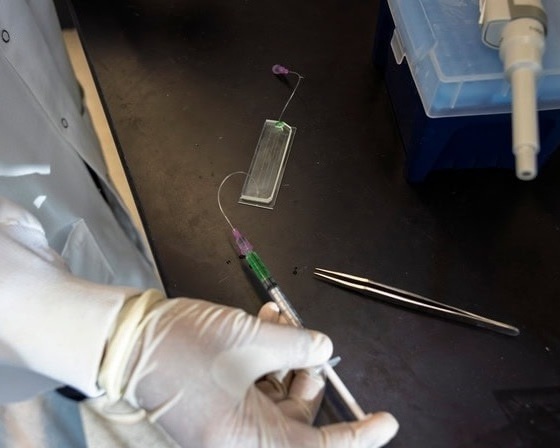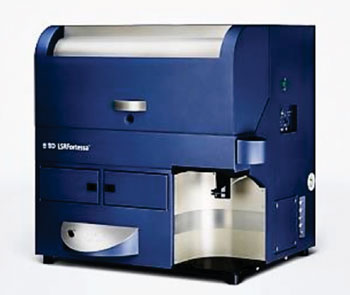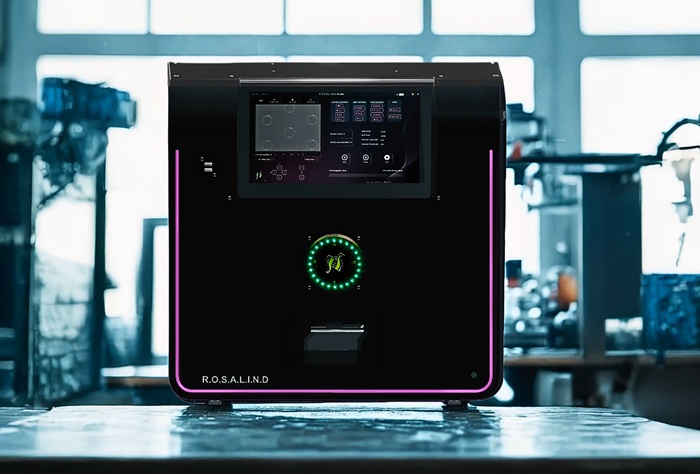Cell Marker Enables Pathogenic Infection Prognosis
|
By LabMedica International staff writers Posted on 14 Oct 2015 |
When a pathogen invades the body, specific cells in the human immune system are ready to take immediate action in order to destroy it, but the molecular characteristics of these killer cells were unknown until recently.
In some patients, viral infections such as Hepatitis B (HBV) can become chronic as a certain amount of the virus remains permanently in the body, however the immune system cannot control the infection and the disease is not completely cured.
A large team of scientists led by those at Technical University of Munich (Germany) obtained peripheral blood mononuclear cells (PBMCs) from patients chronically infected with HBV, hepatitis C (HCV), and healthy donors visiting an outpatient clinic. The team used a variety of techniques to create a molecular profile of the protective cells. By studying these immune cells from patients' blood, they were able to predict the course of infections.
Flow cytometric analyses and assessment of mean fluorescence intensity were conducted with a LSR Fortessa (BD Biosciences; San Jose, CA, USA). Total ribonucleic acid (RNA) was extracted with QIAzol Lysis Reagent (Qiagen; Hilden, Germany) and then purified using the Qiagen miRNeasy Mini Kit. The RNA integrity (RNA Integrity Score equal to or greater than 6.8) and quantity were determined on the 2100 Bioanalyzer (Agilent Technologies; Santa Clara, CA, USA). Peptides were separated on an EASY-nLC 1000 HPLC system (Thermo Fisher Scientific; Waltham, MA, USA) coupled online to the Thermo Fisher Scientific Q Exactive mass spectrometer via a nanoelectrospray source.
The investigators found that the fractalkine-receptor/CX3CR1 distinguishes memory CD8+ T cells with cytotoxic effector function from those with proliferative capacity, independent of tissue-homing properties. CX3CR1-based transcriptome and proteome-profiling defined a core signature of memory CD8+ T cells with effector function. They found CD62LhiCX3CR1+ memory T cells that reside within lymph nodes. This population showed distinct migration patterns and positioning in proximity to pathogen entry sites. Virus-specific CX3CR1+ memory CD8+ T cells were scarce during chronic infection in humans but increased when infection was controlled spontaneously or by therapeutic intervention.
Percy A. Knolle, MD, a professor and lead author of the study, said, “Assessing a patient's ability to control an infection has always been a protracted process, because there were no markers to reliably label killer cells, the real 'task force' of the immune system, yet this type of prediction is extremely important for selecting a suitable course of treatment. The new marker will make predictions about the course of infections much faster and more precise. All we need to do is take blood from the patient and identify the number of killer cells using the new marker.” The study was published on September 25, 2015, in the journal Nature Communications.
Related Links:
Technical University of Munich
BD Biosciences
Qiagen
In some patients, viral infections such as Hepatitis B (HBV) can become chronic as a certain amount of the virus remains permanently in the body, however the immune system cannot control the infection and the disease is not completely cured.
A large team of scientists led by those at Technical University of Munich (Germany) obtained peripheral blood mononuclear cells (PBMCs) from patients chronically infected with HBV, hepatitis C (HCV), and healthy donors visiting an outpatient clinic. The team used a variety of techniques to create a molecular profile of the protective cells. By studying these immune cells from patients' blood, they were able to predict the course of infections.
Flow cytometric analyses and assessment of mean fluorescence intensity were conducted with a LSR Fortessa (BD Biosciences; San Jose, CA, USA). Total ribonucleic acid (RNA) was extracted with QIAzol Lysis Reagent (Qiagen; Hilden, Germany) and then purified using the Qiagen miRNeasy Mini Kit. The RNA integrity (RNA Integrity Score equal to or greater than 6.8) and quantity were determined on the 2100 Bioanalyzer (Agilent Technologies; Santa Clara, CA, USA). Peptides were separated on an EASY-nLC 1000 HPLC system (Thermo Fisher Scientific; Waltham, MA, USA) coupled online to the Thermo Fisher Scientific Q Exactive mass spectrometer via a nanoelectrospray source.
The investigators found that the fractalkine-receptor/CX3CR1 distinguishes memory CD8+ T cells with cytotoxic effector function from those with proliferative capacity, independent of tissue-homing properties. CX3CR1-based transcriptome and proteome-profiling defined a core signature of memory CD8+ T cells with effector function. They found CD62LhiCX3CR1+ memory T cells that reside within lymph nodes. This population showed distinct migration patterns and positioning in proximity to pathogen entry sites. Virus-specific CX3CR1+ memory CD8+ T cells were scarce during chronic infection in humans but increased when infection was controlled spontaneously or by therapeutic intervention.
Percy A. Knolle, MD, a professor and lead author of the study, said, “Assessing a patient's ability to control an infection has always been a protracted process, because there were no markers to reliably label killer cells, the real 'task force' of the immune system, yet this type of prediction is extremely important for selecting a suitable course of treatment. The new marker will make predictions about the course of infections much faster and more precise. All we need to do is take blood from the patient and identify the number of killer cells using the new marker.” The study was published on September 25, 2015, in the journal Nature Communications.
Related Links:
Technical University of Munich
BD Biosciences
Qiagen
Read the full article by registering today, it's FREE! 

Register now for FREE to LabMedica.com and get access to news and events that shape the world of Clinical Laboratory Medicine. 
- Free digital version edition of LabMedica International sent by email on regular basis
- Free print version of LabMedica International magazine (available only outside USA and Canada).
- Free and unlimited access to back issues of LabMedica International in digital format
- Free LabMedica International Newsletter sent every week containing the latest news
- Free breaking news sent via email
- Free access to Events Calendar
- Free access to LinkXpress new product services
- REGISTRATION IS FREE AND EASY!
Sign in: Registered website members
Sign in: Registered magazine subscribers
Latest Immunology News
- Blood Test Could Identify Colon Cancer Patients to Benefit from NSAIDs
- Blood Test Could Detect Adverse Immunotherapy Effects
- Routine Blood Test Can Predict Who Benefits Most from CAR T-Cell Therapy
- New Test Distinguishes Vaccine-Induced False Positives from Active HIV Infection
- Gene Signature Test Predicts Response to Key Breast Cancer Treatment
- Chip Captures Cancer Cells from Blood to Help Select Right Breast Cancer Treatment
- Blood-Based Liquid Biopsy Model Analyzes Immunotherapy Effectiveness
- Signature Genes Predict T-Cell Expansion in Cancer Immunotherapy
- Molecular Microscope Diagnostic System Assesses Lung Transplant Rejection
- Blood Test Tracks Treatment Resistance in High-Grade Serous Ovarian Cancer
- Luminescent Probe Measures Immune Cell Activity in Real Time
- Blood-Based Immune Cell Signatures Could Guide Treatment Decisions for Critically Ill Patients
- Novel Tool Predicts Most Effective Multiple Sclerosis Medication for Patients
- Companion Diagnostic Test for CRC Patients Identifies Eligible Treatment Population
- Novel Tool Uses Deep Learning for Precision Cancer Therapy
- Companion Diagnostic Test Identifies HER2-Ultralow Breast Cancer and Biliary Tract Cancer Patients
Channels
Clinical Chemistry
view channel
Noninvasive Blood-Glucose Monitoring to Replace Finger Pricks for Diabetics
People with diabetes often need to measure their blood glucose multiple times a day, most commonly through finger-prick blood tests or implanted sensors. These methods can be painful, inconvenient, and... Read more
POC Breath Diagnostic System to Detect Pneumonia-Causing Pathogens
Pseudomonas aeruginosa is a major cause of hospital-acquired and ventilator-associated pneumonia, particularly in lung transplant recipients and patients with structural lung disease. Its ability to form... Read moreMolecular Diagnostics
view channel
World's First NGS-Based Diagnostic Platform Fully Automates Sample-To-Result Process Within Single Device
Rapid point-of-need diagnostics are of critical need, especially in the areas of infectious disease and cancer testing and monitoring. Now, a direct-from-specimen platform that performs genomic analysis... Read more
Rapid Diagnostic Breakthrough Simultaneously Detects Resistance and Virulence in Klebsiella Pneumoniae
Antibiotic resistance is a steadily escalating threat to global healthcare, making common infections harder to treat and increasing the risk of severe complications. One of the most concerning pathogens... Read moreHematology
view channel
MRD Tests Could Predict Survival in Leukemia Patients
Acute myeloid leukemia is an aggressive blood cancer that disrupts normal blood cell production and often relapses even after intensive treatment. Clinicians currently lack early, reliable markers to predict... Read more
Platelet Activity Blood Test in Middle Age Could Identify Early Alzheimer’s Risk
Early detection of Alzheimer’s disease remains one of the biggest unmet needs in neurology, particularly because the biological changes underlying the disorder begin decades before memory symptoms appear.... Read more
Microvesicles Measurement Could Detect Vascular Injury in Sickle Cell Disease Patients
Assessing disease severity in sickle cell disease (SCD) remains challenging, especially when trying to predict hemolysis, vascular injury, and risk of complications such as vaso-occlusive crises.... Read more
ADLM’s New Coagulation Testing Guidance to Improve Care for Patients on Blood Thinners
Direct oral anticoagulants (DOACs) are one of the most common types of blood thinners. Patients take them to prevent a host of complications that could arise from blood clotting, including stroke, deep... Read moreMicrobiology
view channel
New UTI Diagnosis Method Delivers Antibiotic Resistance Results 24 Hours Earlier
Urinary tract infections affect around 152 million people every year, making them one of the most common bacterial infections worldwide. In routine medical practice, diagnosis often relies on rapid urine... Read more
Breakthroughs in Microbial Analysis to Enhance Disease Prediction
Microorganisms shape human health, ecosystems, and the planet’s climate, yet identifying them and understanding how they are related remains a major scientific challenge. Even with modern DNA sequencing,... Read morePathology
view channel
AI Tool Simultaneously Identifies Genetic Mutations and Disease Type
Interpreting genetic test results remains a major challenge in modern medicine, particularly for rare and complex diseases. While existing tools can indicate whether a genetic mutation is harmful, they... Read more
Rapid Low-Cost Tests Can Prevent Child Deaths from Contaminated Medicinal Syrups
Medicinal syrups contaminated with toxic chemicals have caused the deaths of hundreds of children worldwide, exposing a critical gap in how these products are tested before reaching patients.... Read more
Tumor Signals in Saliva and Blood Enable Non-Invasive Monitoring of Head and Neck Cancer
Head and neck cancers are among the most aggressive malignancies worldwide, with nearly 900,000 new cases diagnosed each year. Monitoring these cancers for recurrence or relapse typically relies on tissue... Read moreTechnology
view channel
Diagnostic Chip Monitors Chemotherapy Effectiveness for Brain Cancer
Glioblastoma is one of the most aggressive and fatal brain cancers, with most patients surviving less than two years after diagnosis. Treatment is particularly challenging because the tumor infiltrates... Read more
Machine Learning Models Diagnose ALS Earlier Through Blood Biomarkers
Amyotrophic lateral sclerosis (ALS) is a rapidly progressive neurodegenerative disease that is notoriously difficult to diagnose in its early stages. Early symptoms often overlap with other neurological... Read moreIndustry
view channel
BD and Penn Institute Collaborate to Advance Immunotherapy through Flow Cytometry
BD (Becton, Dickinson and Company, Franklin Lakes, NJ, USA) has entered into a strategic collaboration with the Institute for Immunology and Immune Health (I3H, Philadelphia, PA, USA) at the University... Read more
























